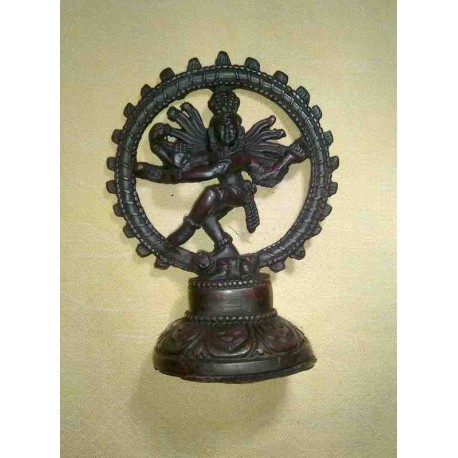No products
- English
- Ελληνικά
 View larger
View larger - Remove this product from my favorite's list.
- Add this product to my list of favorites.
Shiva Nataraj Resin statue From Nepal
New product
4 Items
Height 14cm
Nataraja, is a depiction of the Hindu God Shiva as the cosmic dancer who performs his divine dance (called Tandavam) to destroy a weary universe and prepare for its renewal, by the god Brahma who starts the process of creation.
The sculpture is usually made in bronze, with Shiva dancing in an aureole of flames, lifting his left leg (or in rare cases, the right leg) and balancing over a demon or dwarf (Muyalaka) who symbolizes ignorance. It is a well known sculptural symbol in India and popularly used as a symbol of Indian culture. Basically it represents the form of angry Lord Shiva that danced furiously after death of Sati, his other half
- A cobra uncoils from his lower right forearm, and the crescent moon and a skull are on his crest. He dances within an arch of flames. This dance is called the Dance of Bliss, (Tamil: ஆனந்த தாண்டவம்) aananda taandavam.
- The upper right hand holds a small drum shaped like an hourglass that is called a ḍamaru in Sanskrit.[7][8][9] A specific hand gesture (mudra) called ḍamaru-hasta (Sanskrit for "ḍamaru-hand") is used to hold the drum.[10] It symbolizes sound originating creation or the beat of the drum as the passage of time.
- The upper left hand contains Agni or fire, which signifies destruction. The opposing concepts in the upper hands show the counterpoise of creation and destruction or the fire of life.
- The second right hand shows the Abhaya mudra (meaning fearlessness in Sanskrit), bestowing protection from both evil and ignorance to those who follow the righteousness of dharma.
- The second left hand points towards the raised foot which signifies upliftment and liberation. It also points to the left foot with the sign of the elephant which leads the way through the jungle of ignorance.
- The dwarf on which Nataraja dances is the demon Apasmara (Muyalaka, as known in Tamil), which symbolises Shiva's victory over ignorance. It also represents the passage of spirit from the divine into material.
- As the Lord of Dance, Nataraja, Shiva performs the tandava, the dance in which the universe is created, maintained, and dissolved. Shiva's long, matted tresses, usually piled up in a knot, loosen during the dance and crash into the heavenly bodies, knocking them off course or destroying them utterly.
- The surrounding flames represent the manifest Universe.
- The snake swirling around his waist is kundalini, the Shakti or divine force thought to reside within everything. This also parallels the cords of life worn by the Brahmins to represent the second rebirth.
- The stoic face of Shiva represents his neutrality, thus being in balance.
Resin statue From Nepal .This type of work with resin is kind of Nepal trade mark ..They make mastrepieces in masks ,statues ,asstrays etc in different colours , and though is a synthetic material , it has a good feeling and looks natural .

